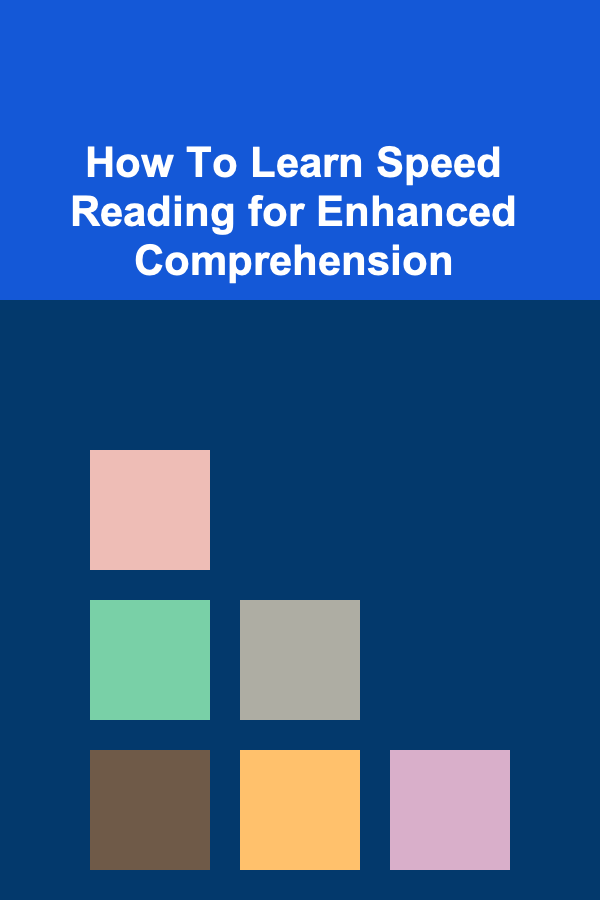
How To Learn Speed Reading for Enhanced Comprehension
ebook include PDF & Audio bundle (Micro Guide)
$12.99$7.99
Limited Time Offer! Order within the next:

In the fast-paced world of information, the ability to read quickly while retaining key information has become an invaluable skill. Speed reading is not just about moving your eyes faster across the page; it's about reading with purpose and understanding. This article delves into the science of speed reading, its benefits, and practical methods for mastering the art of reading quickly and comprehensively.
The Science Behind Speed Reading
Speed reading is often thought of as a technique that allows people to read faster than usual while maintaining or even enhancing their comprehension. However, speed reading is not about mindlessly skimming through the pages; it's a systematic approach that can help you process and retain information at a faster rate. To understand how this works, it's essential to grasp some fundamental concepts about how we read.
How We Read
When we read, our brains engage in several processes, including:
- Recognition of Words: As we read, we recognize individual words, phrases, and sentences.
- Decoding: Our brains decode the words into their meanings.
- Comprehension: We process and understand the information.
Traditional reading involves moving our eyes word by word, often fixating on each word for a fraction of a second. In contrast, speed reading techniques help minimize the number of fixations and expand the amount of information we can process in a single glance.
The Role of Peripheral Vision
One of the core aspects of speed reading is utilizing your peripheral vision. Your eyes have a natural ability to take in information from your peripheral vision, which allows you to read chunks of words instead of individual words. This technique allows readers to expand their attention span and process larger blocks of text in less time.
The Brain's Capacity for Speed Reading
Studies show that the average person can read about 200-300 words per minute (wpm) under normal conditions, with comprehension rates being highest at around 200-250 wpm. However, through speed reading techniques, skilled readers can increase their reading speed to 1000 wpm or even higher, without significantly sacrificing comprehension.
Benefits of Speed Reading
Learning speed reading is more than just about reading quickly---it's about optimizing your brain's ability to absorb and comprehend large amounts of information. Some key benefits of mastering speed reading include:
Increased Productivity
One of the most immediate advantages of speed reading is the ability to process more material in less time. This makes it easier to stay on top of tasks, read research papers, books, and even emails more quickly, boosting your overall productivity.
Enhanced Focus and Attention
Speed reading requires full concentration. By training your brain to focus on larger chunks of text, you improve your ability to focus in other areas of life as well. This increased attention span helps you absorb more information from the material you're reading.
Better Retention
Although it seems counterintuitive, many speed reading methods enhance retention rather than diminish it. By minimizing distractions (such as sub-vocalization, which is when you "say" words in your head while reading), you help your brain focus on understanding the material in context, rather than getting bogged down in the mechanics of reading.
Boosted Learning Ability
Speed reading can greatly improve your learning process. Whether you're reading for academic purposes, self-improvement, or pleasure, speed reading techniques help you learn and comprehend material faster, making it easier to retain critical details.
Reduced Eye Strain
Traditional reading often involves focusing intensely on each word or line of text. Over long periods, this can lead to eye fatigue. Speed reading, however, encourages the use of larger eye movements, which can reduce strain and discomfort during reading.
How to Learn Speed Reading
Speed reading is a skill that can be learned with practice. Like any other skill, it requires patience, consistency, and a willingness to unlearn certain habits. Below are some steps you can take to start improving your reading speed while enhancing your comprehension.
Step 1: Assess Your Current Reading Speed
Before you start practicing speed reading, it's essential to know where you're starting from. Test your current reading speed by timing yourself as you read a passage of text. Count the number of words you read in one minute to establish your baseline reading speed. This will give you a reference point to measure your progress as you continue your practice.
Step 2: Eliminate Sub-vocalization
Sub-vocalization is the habit of silently "saying" words in your head as you read them. While this helps with comprehension at lower speeds, it significantly reduces your reading speed. To overcome this, try reading without subvocalizing. You can do this by focusing on the visual representation of the text rather than the individual words.
One trick to help you stop sub-vocalizing is to use a finger, pen, or pointer to guide your eyes as you move along the page. This keeps your focus on the material and prevents your mind from wandering or verbalizing the text.
Step 3: Use Peripheral Vision
Training yourself to read with peripheral vision can significantly increase your speed. Instead of fixating on individual words, try to expand your focus to include groups of words. This allows you to process the text in chunks, rather than one word at a time. Your eyes can naturally take in a larger portion of the text, which increases your reading speed.
To practice using peripheral vision, start by choosing a section of text and trying to read entire lines at once. With time, you'll develop the ability to grasp more information in one glance, which will help you read faster.
Step 4: Expand Your Eye Movements
Rather than letting your eyes jump from one word to another (a process known as fixations), aim to make fewer, longer eye movements. This means training yourself to read entire phrases or sentences in a single glance, reducing the need for frequent stops. To do this, it's helpful to consciously minimize the eye movements between words and train your eyes to make larger, smoother movements across the page.
Step 5: Use the Pointer Method
The pointer method is one of the simplest and most effective speed reading techniques. By using your finger, pen, or another pointer to guide your eyes across the page, you can increase your reading speed. The pointer acts as a visual cue that keeps your eyes moving forward without unnecessary stops. This method also helps to prevent your mind from wandering and keeps you engaged with the text.
Step 6: Practice Skimming and Scanning
Skimming is a technique used to get the gist of the material without reading every single word. When skimming, focus on headings, subheadings, and the first and last sentences of each paragraph. Scanning, on the other hand, involves searching for specific information. By practicing skimming and scanning, you can quickly gather key points from a text, which can be especially useful when reviewing large volumes of material.
Step 7: Read in Blocks
When you read in blocks, you group words into chunks instead of reading word by word. For example, instead of reading the words "the quick brown fox," read it as "the quick brown" and then "fox" in a single glance. This method allows your eyes to move across the page faster and enables you to process larger sections of information at once.
Step 8: Use Technology to Assist Your Learning
There are many apps and tools available that can help you learn speed reading. These apps use techniques like flashcards, pacing tools, and reading challenges to train you to read faster. Some popular speed reading apps include:
- Spreeder: A free tool that helps you increase your reading speed by displaying words at a set pace.
- Acceleread: This app teaches you to read faster through guided lessons and drills.
- Outread: It's a mobile app that helps you improve your reading speed by using guided reading practices.
Step 9: Regular Practice
Like any skill, speed reading requires regular practice. Start with short reading sessions and gradually increase the time as you get more comfortable. Make it a habit to practice every day, even if it's only for a few minutes. Track your progress over time to see improvements in your speed and comprehension.
Improving Comprehension Alongside Speed
One of the most common misconceptions about speed reading is that it sacrifices comprehension for speed. However, this is not true if you apply the right techniques. The key to retaining what you read is to focus on understanding the text as you go. Here are some tips for improving your comprehension while reading faster:
Focus on the Main Idea
When speed reading, aim to understand the main ideas of the text rather than getting bogged down in every detail. Focus on understanding the thesis, key arguments, and conclusions. This approach will help you retain the most important information.
Take Notes
Taking notes while reading helps you actively engage with the material. Jot down key points, quotes, and ideas that you can refer to later. This reinforces your comprehension and makes it easier to recall the information when needed.
Practice Active Reading
Active reading involves asking questions as you read, summarizing key points, and making connections between different sections of the text. By staying engaged with the material and interacting with the content, you will enhance both your comprehension and retention.
Review What You Read
After finishing a section or chapter, take a moment to review the material. This can be done by mentally summarizing the key points or revisiting your notes. Regular review helps to solidify the information in your memory and boosts long-term retention.
Conclusion
Speed reading is a powerful skill that can help you process large amounts of information in a short period of time. By training your eyes and brain to read more efficiently, you can enhance your comprehension, boost productivity, and improve your overall learning abilities. The key to mastering speed reading lies in consistent practice, a focus on comprehension, and utilizing the right techniques. With time and effort, you'll be able to read faster without sacrificing the quality of your understanding.

How to Curate a Themed Antique Collection
Read More
How to Design a Small Walk-In Closet with Plenty of Storage
Read More
How to Use Wall Shelves for Decorative Organization
Read More
How To Create Effective Data Visualizations
Read More
How To Build a Simple Authentication System
Read More
Prioritizing Your Personal Life Alongside Work: A Comprehensive Guide
Read MoreOther Products

How to Curate a Themed Antique Collection
Read More
How to Design a Small Walk-In Closet with Plenty of Storage
Read More
How to Use Wall Shelves for Decorative Organization
Read More
How To Create Effective Data Visualizations
Read More
How To Build a Simple Authentication System
Read More